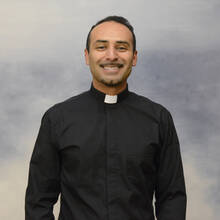This Lent, follow something deeper than identity
Identity is only a half-truth. One needs the whole picture to shape self-understanding. However, the whole picture only comes at the latter end of our life journey.
“Do not tell the vision to anyone until the Son of Man has been raised from the dead.” (Mt 17:9)
Have concerns about personal identity obscured a deeper understanding of God’s call?
How does your life reflect Jesus’ life today?
When have you settled mistakenly for a half-truth?
This Sunday’s passage from Matthew’s Gospel highlights Jesus’ transfiguration on a mountain into his full brilliance, glory and power. This vision is both expansive and limited. The vision provides a glimpse into Jesus’ full glory, but remains limited without the reality of the cross. Jesus’ glorious revelation is critical in this scene, but there is something deeper than identity. This something else, something deeper, can be seen on the mountaintop as Jesus tells his disciples that the full picture of his identity has not yet been revealed. They must wait.
In last Sunday’s Gospel passage, the tempter tried to seduce Jesus into denying his divine kinship to the Father (see Mt 4:1-11). Twice the tempter says, “If you are the Son of God,” which creates an opportunity for Jesus to doubt his fundamental role on earth. In the third temptation, the tempter takes Jesus to a mountaintop and offers authority over the nations in exchange for Jesus’ surrender to the devil’s will. Jesus’ response forces Satan to flee, and the devil leaves for the time being.
Identity is only a half-truth. One needs the whole picture to shape self-understanding.
In this Sunday’s Gospel passage, Jesus brings his disciples, Peter, James and John, to his own mountaintop experience. The scene reminds readers of Moses’ meeting with God on the mountaintop (Ex 34:29-30). Mountains are places where the earth touches the heavens, where God’s footstool meets the divine throne. A voice speaks from the cloud and serves as a reminder of Jesus’ deepest sense of identity, “This is my beloved Son, with whom I am well pleased; listen to him” (Mt 17:5). This phrase hearkens back to biblical traditions like the one found in Psalm 2, “You are my son, today I have begotten you” (Ps 2:7). Each of the Gospels cites this verse directly or indirectly to emphasize Jesus’ identity as the Son of God.
The phrase, “This is my beloved Son, with whom I am well pleased,” appears throughout the Gospels, a repetition that gives evidence of its importance to early Christian writers. Matthew believes this line was critical for Jesus’ self-understanding. Moreover, while Jesus is on this mountaintop, the vision includes a glimpse of Moses and Elijah. This suggests that Jesus fulfills three roles as the lawgiver (Moses), as the fulfillment of prophecy (Elijah) and as the anointed one to come (Ps 2:7). Jesus’ identity seems secure, nothing more is needed. The voice from the clouds reinforces this identity by repeating the divine proclamation from Jesus’ baptism, “This is my beloved son” (see Mt 3:17).
But the message of the transfiguration is incomplete on its own without the paschal mystery that is to come. Jesus’ self-understanding is not the most significant consequence of the divine proclamation. Likewise, Peter’s witness and the other disciples’ testimony to this vision is not critical to the mission. This sounds strange, but the text is clear on this. “As they were coming down from the mountain,” Jesus reminds his disciples, “Do not tell the vision to anyone until the Son of Man has been raised from the dead” (Mt 17:9). The full revelation of Jesus must include the cross, death and being raised into glory.
The Gospel today implies that the deepest reality is not one’s self-understanding as a child of God. The “deeper something” comes when one takes the divine voice as a motivation to trust in God during the hardships on the journey. This is the walk Jesus makes of his life. This is the walk all disciples make during Lent. Without Jesus’ full walk, without the Lord’s passion, the transfiguration remains incomplete.








